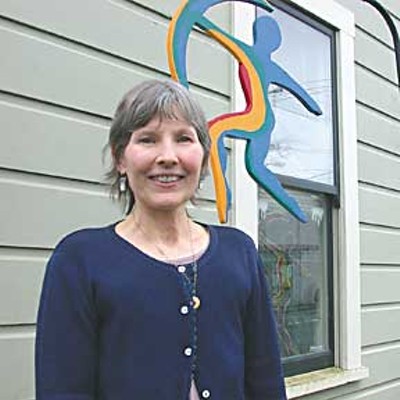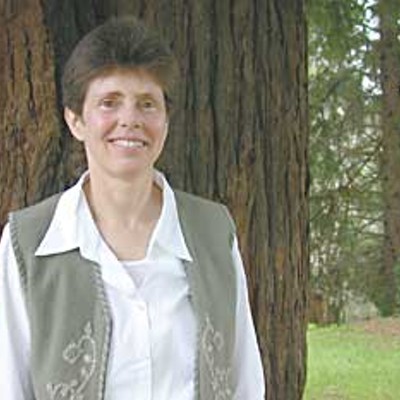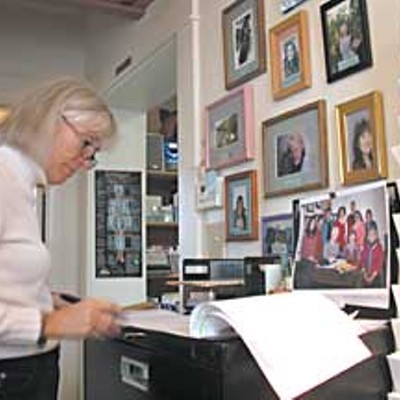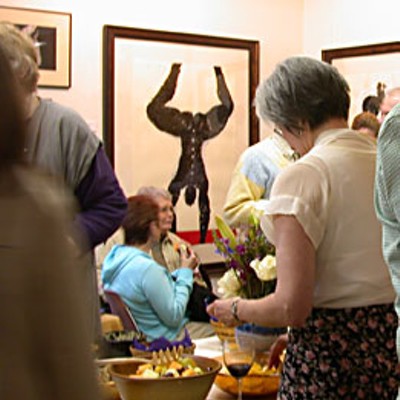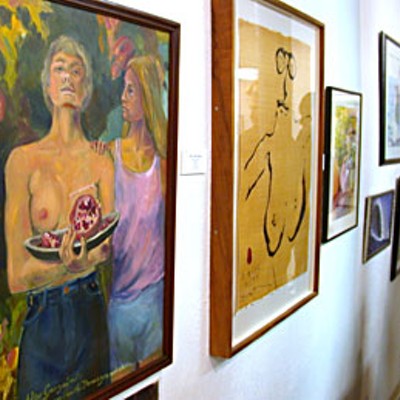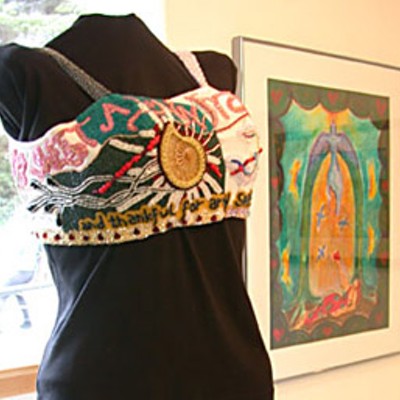[
{
"name": "Top Stories Video Pair",
"insertPoint": "7",
"component": "17087298",
"parentWrapperClass": "fdn-ads-inline-content-block",
"requiredCountToDisplay": "1"
}
]
For almost three years doctors had been assuring Bonnie Etz that the large lump she felt in her breast was probably just dense fiber, nothing to worry about. So when Etz found out in 2004 that she had a rare and advanced case of breast cancer she felt betrayed and distraught. But her husband was the one who fell apart at the news. Reluctant to burden his sick wife with his intense feelings, all the fear and anger he'd been experiencing stayed bottled up.
Noticing that Dave Etz was having a particularly difficult time with the diagnosis, Bonnie's surgeon, Dr. Ellen Mahoney, referred him to the Humboldt Community Breast Health Project, an Arcata nonprofit. She assured him it was a good place to learn about what to expect during his wife's journey through a mastectomy and chemotherapy, and also to find a sympathetic ear.
So Dave took the doctor's advice, made the call and continued to completely lose it on the phone. He cried and swore at the woman who answered. But Sharon Nelson, the recipient of his outburst, wasn't offended. She just listened and let the unhinged man get everything off his chest. Nelson, who is now the Humboldt Community Breast Health Project's (HCBHP) client services director, understood the man's pain. Her family went through it too, back when she was diagnosed with breast cancer in 1999.
Bonnie Etz, 55, has since come full circle. Now she's the one answering phones. Etz is what the HCBHP calls a "warm liner," a volunteer who takes calls from people, usually women, who have a question about breast or gynecological cancer. Warm liners are prepared to talk with people at any stage on their road to recovery. That might be a woman who just discovered a lump and isn't sure what to do next. Or it could be a return client wanting to talk about reconstructive surgery with someone who already went through it.
Etz is one of a dozen warm liners - most of them, like her, are breast cancer survivors - and last year alone they made 4,308 client contacts, 193 of them with first-time clients. Butmore often than receiving calls or walk-ins, the warm liners are the ones reaching out, going through their log books and calling women who they haven't heard from in a while, or checking in on someone who recently had an oncologist's appointment.
"It's important for women to know that they're not just a statistic," Etz said.
*According to 2006 figures**in the state's annual death rate report, the County Health Status Profiles, Humboldt County ranks last in many of the*death categories - everything from random accidents to diabetes. In other words, if the statistics paint an accurate picture, Humboldt County is a dangerous place to live.
Each year the California Department of Health Services analyzes the death rate data over a three-year spread and publishes the yearly average. The most recent statistics come from the period between 2002 and 2004.
First up on the 80-page report is the catchall category, "Deaths due to all causes." With an age-adjusted death rate of 944.6 people a year per 100,000 population, Humboldt ranks second to last: 57th out of 58 California counties. By comparison the adjusted average for the state is just 704.5 people yearly.
Next on the list: deaths from motor vehicle crashes. Humboldt ranks 40th with 23.6 fatalities annually. Deaths due to unintentional injuries? Number 55, with 72.9 deaths a year. But it gets worse. Upon closer inspection, those three lesser-ranking counties -- Mariposa, Modoc and Sierra - come with a caveat: The state considers their statistics unreliable, denoted by a small, hovering asterisk. When thoseasterisks are accounted for, Humboldt is technically the worst place for fatal drownings, plane crashes, falls, etc.
The same technicality applies for both firearm injury deaths and suicides. We're dead last in both categories. Homicide, number 52 on the list (though our statistics are asterisked). Drug-induced deaths? Number 58 - last yet again, with an average of 29.8 people dying each year between 2002 and 2004.
All cancers, number 54. Lung cancer, 52.
And then, a merciful ray of sunshine appeared on page 20: Breast cancer. Number 17. Humboldt County even squeaked in above the Healthy People 2010 National Objective. Our average death rate was 15.3 deaths per year, down by four deaths from the 2005 numbers, which analyzed death certificates from 2001 through 2003. However, in the most recent batch of statistics, ours were considered unreliable.
"It actually is a statistical blip," said county Public Health Officer Dr. Ann Lindsay.
For almost a decade, Humboldt County has been at the bottom of the barrel for breast cancer deaths, then suddenly, we climbed the chart 36 spots between 2005 and 2006. Since Humboldt's population is small compared to many other California counties, even a shift of just three or four deaths dramatically skews our standing.
"We're always pleased when the overall number of deaths go down," said Peggy Falk, deputy branch director of the county's Department of Health and Human Services. "But from a public health point of view, what we look for is if it is a statistically significant change or if it is just an expected fluctuation. And this, according to our epidemiologist, is not a statistically significant change."
In Los Angeles County, by comparison, an average of 1,072.3 women died yearly between 2001-2003. Then between 2002-2004, an average of 1095.3 women died each year. That's a shift of 22 deaths, more than the annual death rate in Humboldt County. However, L.A.'s ranking only shifted downward by one spot, from 22 to 23.
So where does this reallyleave Humboldt in the ranks when it comes to breast cancer deaths? Probably somewhere in the middle of the pack, but it'shard to know for sure.
Humboldt Community Breast Health Project Founder Dr. Julie Ohnemus said that whileHumboldt's long-depressing statistics were part of her motivation for starting such an organization, she doesn't let the numbers dictate her perception of success.
"For me it's the process and not the outcome anyway," said Ohnemus. "It was a good year even if it is a blip and hopefully we'll see it sustained." The next batch of stats is due out next month, during National Public Health Week. Ohnemus and other public health officials are waiting to see if Humboldt stays atop the chart before patting themselves on the back.
When Dr. Ohnemus, a familyphysician at the North Country Clinic, was diagnosed with breast cancer at age 36, her doctor, a colleague, told her that she was "doomed." That was the word the doctor used - "doomed." The cancer cells in her chest were resisting treatment, and there was a good chance she would not live much longer.
Ohnemus, a spritely woman with short spiky hair, recently recalled how after that doctor's visit in 1996, she could not escape that word. "Doomed." It consumed her. She imagined it was written across her forehead in bold letters, alerting everyone to her illness.
And then, she said, one day she looked in the mirror and, in her mind,the letters transposed themselves: Mood. "It was a huge turning point," she said. She realized her life was in her own hands.
"Attitude is what carries you through," she said matter-of-factly. Eleven years after her diagnosis, the cancer has not come back. So, does she have a grudge against Dr. Doom? None at all, she said. Andjudging by her easy laughter and nearly-constant smile, you believe her. Life's too short to harbor resentments, she's learned. If anything, she thinks the experience provoked her to fight much harder.
While receiving treatments in Palo Alto at the Stanford University Medical Center, Ohnemus discovered the Community Breast Health Project, an organization where cancer patients could getsupport and information about their disease, free of charge. It was then that she decided to create something similar in Humboldt County - a survivor-run program to help women navigate the medical complexities of their treatments and also provide them with a source of hope.
The Humboldt Community Breast Health Project's 1997 beginnings were humble. For a while Ohnemus and six other cancer survivors held meetings at her kitchen table in Westhaven.
But the Project quickly outgrew Ohnemus' digs, and a variety of other small Arcata venues along the way. Their growth was simultaneously delightful and mortifying. They hated that the need was so great. Breast cancer, Ohnemus said, is the No. 1 diagnosed cancer in Humboldt County, and our rates compared to other counties are relatively high.But they were thrilled that so many women were responding to their outreach efforts.
In 2004, HCBPH expanded its services to include gynecological cancer survivors, and around the same time it won a grant to beef up its outreach efforts to the local Native American and Latina communities. And while it is unclear if the project has made a dent in the rates of breast cancer deaths, Dr. Alan Glaseroff, chief medical officer of the Humboldt-Del Norte Independent Practitioners Association,said the number of IPA patients receiving mammograms has climbed dramatically in recent years. In 2006, 85 percent of women over 40 received mammograms, up from 75 percent in 2005. Early detection of breast tumors plays a major role in survival rates.
These days the HCBHP has about 200 volunteers, a $180,000 budget and seven paid staff members. And once again it appears to be outgrowing its home, a two-story house in downtown Arcata that is often bubbling with conversationand crammed with women.
"It was instant love," said Bonnie Etzearlier this month, as she recalled her first visit to the Humboldt Community Breast Health Project. "I thought, when this is over I'm going to be here" - as a volunteer.
Sitting on a couch in the front office of the HCBPH, Etz remembered one of her first visits to the Project. Mary Scott, a nurse and the former client services director, asked Etz if she wanted to see her mastectomy scar, something known in survivor circles as an "Amazon scar." (Legend has it that female Amazon warriors would cut off their breast to better use a bow and arrow. The HCBPH's logo is the silhouette of an Amazon.)
Etz's first response was "No, thank you."
"Here I am this proper Irish Catholic girl," Etz said, sitting up straight,and making a face. "I don't want to see someone's scar." But she gave it a second thought, let down her guard and said, sure.
"[Mary] just whipped up her blouse and I thought, Oh, that's not so bad. It actually looks OK,'" she said. "I thought,I can do this.'"
It's this kind of unrestricted sharing that other clients and volunteers say helped them not only get a better understanding of cancer's physical toll but also helped them grow emotionally and spiritually.
"When you're facing a life-threatening disease," said Sharon Nelson, "you tend to cut to the chase of what's really important in life.'
Like Dr. Ohnemus, Etz believes that her attitude toward her illness is what saved her. Before each chemo session at Eureka Internal Medicine, she would listen to "guided imagery" tapes that Blue Cross sent her.
"When I was in treatment," she said, "I always tried to make it that Iwas doing the healing."
That's a pretty alternative view, especially for people of Etz's age group, a baby boomergeneration that still views their doctor as an authority figure who shouldn't be questioned. But for Etz, looking back, she wished she trusted her own instincts and challenged her doctors when they said she didn't have breast cancer.
HCBHP clients are taught how to stay informed about their disease, to know their treatment options and become their own "medical advocate." They have open membership to support groups and free use of the extensive cancer library. And staff RNs Sharon Nelson and Rebecca Zetler will help them communicate with their doctors should they need it.
For many women, the first step to taking control of their journey through breastcancer is to go through "consultation planning" with a project staff member. The hour-long consultation planning process allows a client to discuss any treatment concerns or questions she has for the doctor. The staff takes notes and sends a copy to the doctor to review before the patient's visit. And often, a volunteer will even accompany a woman to her appointments - some of which can last several hours - to take notes.
Not only is the patient then less likely to "draw a blank" at her appointment, but the doctor will already have a better sense of her needs and fears.
"I think that the breast health project has a real effect here," said Public Health Officer Ann Lindsay. "First, it makes the whole scary process of being diagnosed more manageable, and there are studies of women who participate in support groups do better with their whole outlook. And they have Dr. Ohnemus and Dr. Mahoney who have worked with the medical community about the proper management of breast lumps and communication with women."
You can hardly talk about breast cancerin Humboldt County without someone mentioning Dr. Ellen Mahoney. But actually talking toDr. Ellen Mahoney is another matter.
She couldn't schedule time for a phone interview with the Journaluntil the end of March. Her peers and patients say the woman is extraordinarily busy - involved in a number of medical organizations and a forerunner in local health care reform efforts, not to mention being a nationally renowned surgeon in her field. Even Oprah Winfrey has recognized her efforts.
Two weekends ago, in fact, she was in Los Angeles working with fellow breast cancer surgeon and author Dr. Susan Love. In 2000, Mahoney and Love together rolled out a groundbreaking, minimally invasive cancer detection procedure called ductal lavage. Under Mahoney's guidance, Humboldt County hospitals were among the first in the country to put the new technique into practice.
And, coincidentally, Mahoney is the founder Palo Alto's Community Breast Health Project, the organization that gave Dr. Julie Ohnemus a model for the local Project. Mahoney, a Stanford graduate, started the CBHP - the first of its kind-in 1993 with a breast cancer patient after they realized that women needed more than just the medical expertise of a doctor. They needed hope.
"[Mahoney] is incredibly generous with her time," said Dr. Lindsay, "with organizations and individual women who are facing cancer issues. Not that other people aren't [generous], but because of her stature in the national medical community I think it gives confidence to people who consult her locally. She's in with the newest techniques and she keeps other surgeons abreast of things."
That's another issue that often comes up when people talk about Dr. Mahoney: Sure she's nationally renowned and benevolent to boot, but she's Not the Only One. More than once it happened at the Project; someone would talk to a reporter glowingly about Mahoney then ask that you not write too much about her. "We're not steering patients to Ellen; it's not the case," one volunteer asserted. Besides, she went on, she's not taking new patients, just the really difficult cases.
The Project is intent on maintaining good rapport in the medical community and has been reaching out to doctors to help themunderstand their patients' needs better. One example is a new program called "MD Open House," where a local doctor comes by the Arcata office to answer patient questions and discuss his or her work.
Earlier this month, Dr. Phil Vogelsang, an Arcata pathologist, spoke with 10 women about his job - looking for cancer under a microscope.
Client Services Director Sharon Nelson said the meetings are a good chance for doctors to take off that white coat - an intimidating boundary for patients - and relate to the women on a more casual level.
On March 4, the Westhaven Center for the Artshosted an opening called "Journey of the Heart,"an art show featuring work of breast and gynecologicalcancer survivors and their supporters. Over 30 artists participated and sales of the work benefit the Humboldt Community Breast Health Project.
The Sunday afternoon reception had a great turnout. The redwood-encased building was packed and noisy with conversation and laughter. Scents of savory hors d'oeuvres and wine mingled in the air. Outside a sign warned parents that some of the art might not be suitable for kids, but there were still kids there, snacking, squirming, happy kids probably there with their moms, the artists.
A number of artpieces dealt directly with mastectomies, including Bonnie Etz's intricately beaded bra that hung on a mannequin in the window.
Etz said that she knew immediately after her surgery that she would have to bead that ugly, padded thing the doctors gave her following the surgery. It was a way to bid farewell to that part of her body, to make something scary into something beautiful. Just days before the show she was still putting the finishing touches on the fabric.
Studies have suggested that art helps people better cope with illness. It's something that Joyce Radtke knows well. For nine years, the 53-year-old Arcata resident has facilitated a grant-funded art group called the Persephone Project, for people with life-threatening illnesses.
Radtke, one of the "founding mothers" of the Humboldt Community Breast Health Project, has battled breast cancer for more than a decade.
Hanging prominently at the Westhaven Center is one of Radtke's most striking pieces, Persephone Returns. Its a brightly colored mixed-media abstract of a woman with a red Amazon scar and an arm draped over her head, feeding herself a pomegranate seed.
Lots of people gravitated to the piece during the reception. One couple wondered out loud about what was meant by some of the symbols that surrounded Persephone's figure. But Radtke wasn't there to explain. Recently she discovered that her cancer has returned for a third time and during the show she was getting ready for a Bay Area doctor's visit.
Radtke gave us permission to use Persephone Returnsfor the cover image of the paper. But she had one stipulation. She asked that we include a passage she wrote to accompany the art. In light of what she is going through now, she said, it felt important to her.
"After I was diagnosed with cancer, I became fascinated by Persephone, the Greek Goddess of eternal spring, of innocence. Abducted to the Underworld, Persephone ate the seeds of the pomegranate, symbol of fruition and creativity. Eventually, she was released, innocent no longer. I imagine that she felt she had a new chance to find her life again, to embrace the light. Like Persephone, I journeyed in the dark realms and used the seeds of creativity to find my way home. By imagining myself as the goddess of eternal spring, I was able to escape from the pain, the losses, the dark and barren landscapes the doctors painted for me. I am returning to the light, to living moments as they come and embracing every second I have."
more from the author
-
My Derby Daze
The girl-power sport on skates prepares to storm the county
- May 22, 2008
-
A sunbeam in the studio
- Jun 14, 2007
-
On the Inside
A snapshot of the Humboldt County Jail
- Jun 7, 2007
- More »
Latest in News
Readers also liked…
-
Through Mark Larson's Lens
A local photographer's favorite images of 2022 in Humboldt
- Jan 5, 2023
-
'To Celebrate Our Sovereignty'
Yurok Tribe to host gathering honoring 'ultimate river warrior' on the anniversary of the U.S. Supreme Court ruling that changed everything
- Jun 8, 2023

